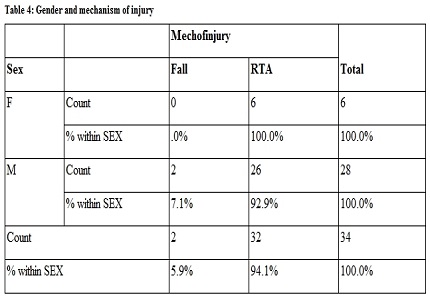Epidemiological profile of patients admitted with closed fractures of shaft of tibia in a tertiary government hospital
Abstract
Introduction: In the recent era of trauma, about one million people get seriously injured annually. Majority of them suffer from lower limb injuries. Due to lack of trauma registry in India, prediction models are not much effective. The aim of our study was to derive basic epidemiological parameters for lower limb injuries which can be used to develop better prediction models to reduce morbidities and mortalities.
Materials and Methods: This study consists of 34 cases of fracture both bones of leg, tibia treated by internal fixation with interlocking tibia from August 2009 to July 2011, and followed upto November 2011.
Results: The average age of cases in this study was 36.18 years. Fracture was more common in age groups between 20 to 39 years. There were 28 male patients and 6 female patients, showing male preponderance.
Conclusion: This study helped us in identifying certain characteristics that may be useful for planning preventive strategies in an attempt to reduce the number of accidents pertaining to lower limbs and redirect public investment in health. We recommend further detailed study in this area to explore more interesting facts which can be made use to develop new preventive measures.
Downloads
References
2. Michael Frink, Frank Hildebrand, Christian Krettek, Jurgen Brand, Stefan Hankemeier. Compartment Syndrome of the Lower Leg and Foot. Clin Orthop Relat Res. 2010 Apr; 468(4): 940–950.
3. Goel SA , Bhavsar NM , Makwana H , Lil NA , Patel PR. Epidemiology and patterns of lower limb injuries at a tertiary care hospital in Ahmedabad. International Journal of Medical Research and Review 06/2015; 3:490-
4. Miki N, Martimbianco AL, Hira LT, Lahoz GL, Fernandes HJ, Dos Reis FB. Profile of trauma victims of motorcycle accidents treated at hospital Sao Paulo. Acta Ortop Bras. 2014;22(4):219-22
5. Keating JF, O'Brien BJ, Blachut PA, et al : Locking intramedullary nailing with and without reaming for open fractures of the tibial shaft. J Bone Joint Surg Am. 1997 Mar;79(3):334-41.
6. Singer RW, Kellam JF: Open tibial diaphyseal fractures: results of undreamed locked intramedullary nailing, Clin Orthop 315:114,1995.
7. Whittle, A. P.; Russell, T. A.; Taylor, J. C.; and Lavelle, D. G.: Treatment of open fractures of the tibial shaft with the use of interlocking nailing without reaming. J. Bone and Joint Surg., 74-A: 1162-1171, Sept. 1992.
8. Browner BD, Wiss DA: GK locking nail for the femur. The science and practice of intramedullary nailing. Philadelphia, Lee and Febyer, 1987.
9. Dinesh Choudary. A Prospective Comparative Study of Reamed vs. Unreamed Nailing in Fractures Shaft of Tibia. Malays Orthop J. 2012 Nov; 6(3): 21–26.

Copyright (c) 2015 Author (s). Published by Siddharth Health Research and Social Welfare Society

This work is licensed under a Creative Commons Attribution 4.0 International License.


 OAI - Open Archives Initiative
OAI - Open Archives Initiative


